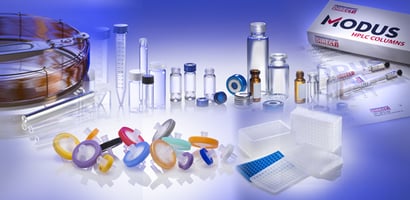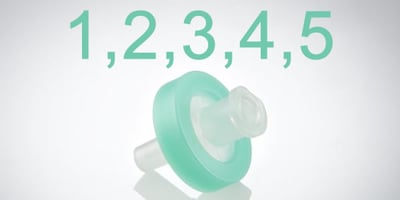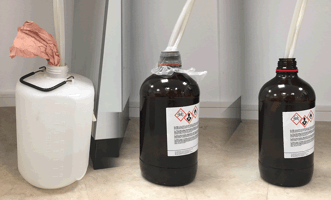Flash Chromatography: A Speedy Solution for Separation & Purification
In the realm of chemistry and biochemistry, the separation and purification of compounds are essential processes. One powerful technique that has revolutionised these fields is flash chromatography.
Flash chromatography is a quick and efficient method to separate and purify mixtures of organic compounds based on their differing polarities. In this blog post, we will explore the principles of flash chromatography, its applications in various industries, and the advantages it offers over other chromatographic techniques.

Flash chromatography operates on the same fundamental principles as other chromatographic techniques, such as column chromatography. It involves the passage of a mobile phase (solvent) through a stationary phase (packed column). The stationary phase consists of a solid material, such as silica gel or a polymer, packed into a glass column or plastic cartridge. The mobile phase carries the sample mixture into the column, and as it flows through, compounds in the mixture interact differently with the stationary phase based on their polarities.
The separation process occurs due to the differential adsorption of compounds onto the stationary phase. Compounds with higher polarity tend to interact more strongly with the stationary phase, leading to slower movement through the column. In contrast, less polar compounds move more rapidly through the column, resulting in their earlier elution. Different compounds can be separated and collected in distinct fractions by carefully selecting the mobile phase composition and adjusting flow rates.
Applications of Flash Chromatography
Flash chromatography has extensive applications across various scientific domains. In organic synthesis, it plays a crucial role in the purification of reaction mixtures. After a chemical reaction, the desired product may be contaminated with impurities, by-products, or unreacted starting materials. Flash chromatography allows chemists to quickly and effectively isolate the target compound quickly and effectively from the complex mixture, providing high-purity samples for further analysis or use.
Flash chromatography is utilised in drug discovery and development processes in the pharmaceutical industry. It enables the separation and purification of synthetic compounds, natural products, and intermediates, aiding in isolating bioactive molecules for biological testing. The ability to isolate and purify compounds rapidly is invaluable in drug discovery, where time is often of the essence.
Additionally, flash chromatography finds applications in the field of natural product chemistry. Natural products derived from plants, microorganisms, or marine organisms, often contain complex mixtures of compounds. Flash chromatography allows researchers to isolate and purify these compounds, facilitating the identification of new chemical entities and characterising their biological activities.
Advantages of Flash Chromatography
Flash chromatography offers several advantages over other chromatographic techniques. Firstly, it is a rapid process. As the name suggests, flash chromatography can separate and purify compounds within minutes, making it highly efficient for routine laboratory work. This speed allows chemists and researchers to process a large number of samples quickly, increasing productivity and saving valuable time.
Secondly, flash chromatography requires relatively small amounts of solvent compared to other chromatographic methods. This reduces the cost of the process and makes it more environmentally friendly by minimising the use of potentially harmful solvents.
Moreover, flash chromatography provides excellent resolution and separation capabilities. The choice of stationary phase, mobile phase, and flow rates can be optimised to achieve optimal separation of compounds, resulting in high-purity fractions. This purity level is crucial for subsequent analytical techniques or biological testing, ensuring accurate results.
Flash chromatography has become an indispensable tool in separation science. Its ability to quickly and efficiently separate and purify organic compounds has made it widely adopted in various industries, including pharmaceuticals, natural product chemistry, and organic synthesis. Flash chromatography continues to contribute to advancements in scientific research and development with its advantages of speed, cost-effectiveness, and high resolution. As technology evolves, we can anticipate further improvements in flash chromatography, opening up new possibilities for rapid and efficient compound purification.
See the range of Flash Chromatography Columns and Accessories available from Chromatography Direct
Modus B Series - Machine packed with economical high-quality gel or Alumina. Ideal for routine academic or basic flash chromatography. Find out more >>
Modus S Series - Machine packed with ultra-pure Silica gel. Ideal for everyday purifications with excellent performance upto 300 psi. Find out more >>
Modus P Series - High pressure spin-welded for pressures upto 400psi. Available in ultra-pure irregular or spherical Silica. Designed for greater efficiency & peak shape. Find out more >>
Modus P Series Bonded - Packed with ultra-pure, high-quality, high efficient bonded Silica. Available in C18, NH2, SAX, SCX, CN and Diol upto 400 psi. Find out more >>
Modus eTWIST/eTWIST Plus - A convenient system for manual assembly, allowing for flexible sample loading method: solid and direct liquid injection. Availble in pre-packed ultra-pure silica, empty solid load cartridges for self packing or eTWIST plus pre-packed with 15% empty space for solid sample loading. Find out more >>
Modus eTWIST Large - Offer the convenience of manual assembly for end users requiring a higher sample quantity. Now available in 800g, 1600g and 3000g. Find out more >>
Modus CBD - Speciality Cannabis Flash Columns. When compared to a Standard Reversed Phase Column, MODUS CBD allows over 200% more loading capacity resulting in improved resolution and isolation of all cannabinoids. Find out more >>



